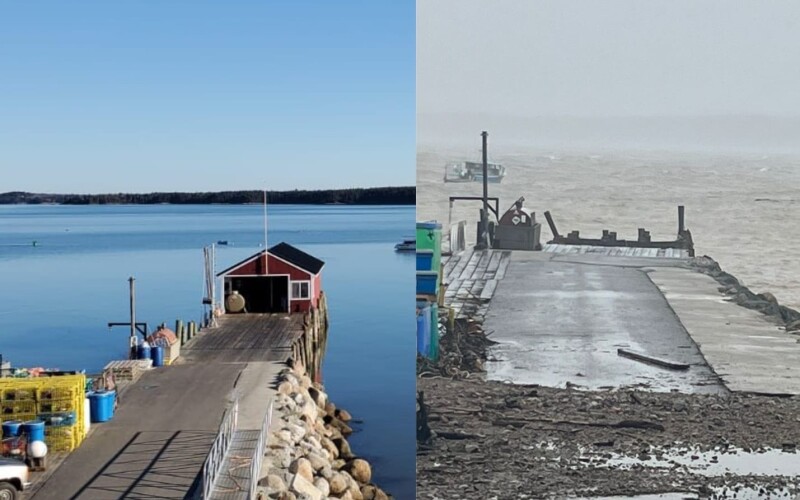Two back-to-back storms devastated the coast of Maine from Jan. 10-13, flooding shoreside infrastructure and tearing away many of the docks that serve the state’s commercial fisheries. Photos of damage from Kittery to Canada filled pages on FaceBook and Instagram.
Now that the waves have diminished and the tides receded, many communities face the prospect of cleaning up and rebuilding.
Milbridge, Maine, lost two important wharfs, Chipman’s Wharf and Jordan Pier. While Jordan is a public pier, Chipman’s Wharf is a private company that buys lobsters, scallops, and other seafood from local boats, and runs a fish market and gift shop.
According to Amity Chipman, a co-owner of the wharf, they sustained considerable damage from the storms and are trying to figure out how to get operational before the 2024 lobster season begins. “We’re buying some scallops right now,” Chipman says. “Our area is closed so the boats are mostly fishing down toward Cutler and Lubec and driving them here. But we lost 110 feet of wharf and the building on the end. We need to get that rebuilt by April.”
Chipman notes that the first thing they have had to do is clean up the mess. “There were 800 traps piled up under the wharf. People in the community came out to help us and they got that all cleaned up in a few hours, other people brought us food. One customer from Massachusetts called and ordered 10 pizzas for us.”
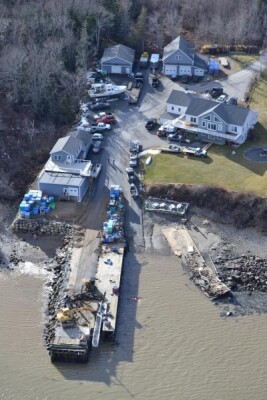
But the clean-up is just the beginning. Rebuilding and paying for it are the big challenges. “From what we’re hearing, this weather may be the new normal,” says Chipman. “So, we can’t just rebuild what we had; it has to be stronger.”
Chipman notes that the Chipman family and their crew built the original wharf. “But doing it again and paying for it, that’s a lot. We were on a virtual meeting with Pat Keliher (Commissioner of Maine’s Department of Marine Resources), and what I understood was that any FEMA (Federal Emergency Management Agency) money would go to rebuilding public wharves first, like Jordan Pier. He said he would see what we could do for us. One thing he mentioned was the possibility of getting low-interest SBA (Small Business Administration) loans.”
Even with funding, the Chipman’s and other private wharf owners have to find someone to do the work. “My husband and his brother and our crew can to a lot of the work,” says Chipman. “They did it before. But we might need to get someone to help, and I don’t know who.”
Chipman also notes that new construction will require new permits, and those can take time. “Hopefully we can get those quickly, the Commissioner said he was going to try and streamline the process. Right now, we are getting daily updates on that, and we’re getting help from the Island Institute; they’re great,” says Chipman, referring to the non-profit organization operating out of Rockland, Maine.
The Marathon
Chipman’s is just one of many wharves and buildings destroyed by the two storms, and according to Stacey Keefer, executive director of the Maine Marine Trades Association, rebuilding the infrastructure will likely take years. “It’s going to be a marathon, not a sprint,” says Keefer. She sees the same challenges as Chipman - funding, permitting, and contractor availability - and adds that low-interest loans may require flood insurance.
“The idea of low-interest loans sounds great, but SBA disaster loans require flood insurance, which can be in the tens of thousands of dollars a year.” Another possible pinch point Keefer sees is the supply chain. “As the demand increases, I’m hoping we don’t run into a shortage of materials,” she says.
In terms of contractors and engineers, Keefer notes that many were booked months, if not years out, even before the storm. “If people can do the work themselves, that might be the best option,” she says, adding that mobilizing marine construction equipment is not easy. “Sometimes getting a barge to the site costs more than the job. These things don’t just zip up and down the coast.”
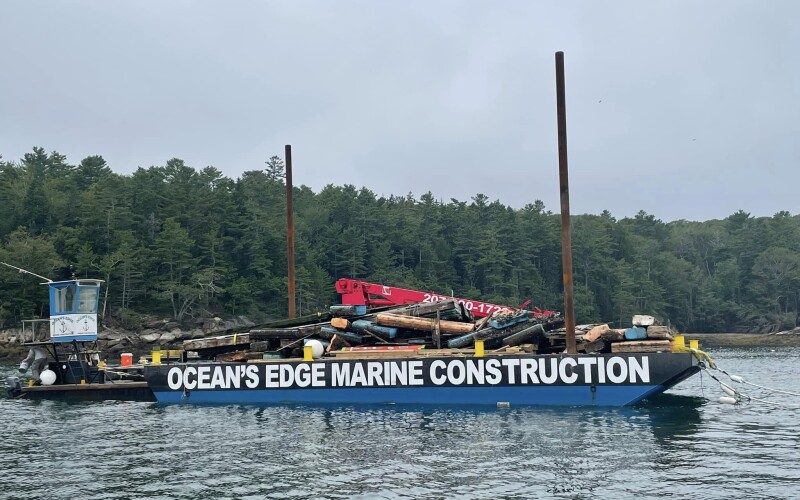
Prock Marine of Rockland, Maine, has hired new people but declined to comment on how the construction company is responding to the disaster. Mark Zaccadelli, owner of Ocean’s Edge Marine in Bristol, Maine - a company whose motto is “small enough to listen, big enough to get the job done” - spoke briefly from the water in Harpswell, Maine. “Right now, we’re still doing demolition,” says Zaccadelli. “The towns of Harpswell and Bristol have hired us to rebuild their docks, and the phone is ringing off the wall.”
Financing
While Maine is seeking FEMA money, the state sent out an email on Jan. 19 with information on low interest loan providers and technical assistance for rebuilding. According to the Department of Marine Resources web page, FAME, the Finance Authority of Maine, will offer loan insurance up to $1.5 million and direct loans for as much as $1 million, noting that most FAME direct loans are for less than $500,000. Five other Maine agencies providing assistance are listed on the web page, as well as private organizations such as the previously mentioned Island Institute, Coastal Enterprises Inc., a non-profit group in Brunswick, Maine, and national lenders, including the Small Business Administration and the NOAA Fisheries Finance Program. In addition to financial help, the DMR page also provides guidance on the permitting process.
“Besides the website, we’ve mailed all this information to license holders,” says Jeff Nichols, spokesman for the DMR. “The Governor (Maine Gov. Janet Mills) has invited FEMA to come and validate the damage.”
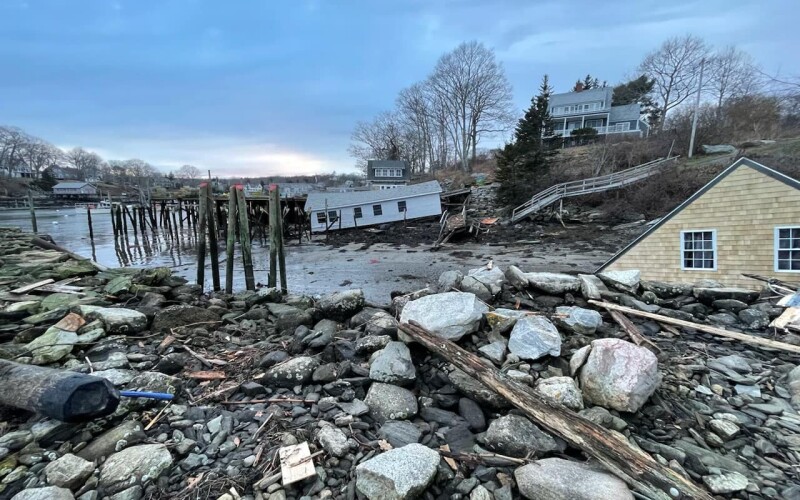
Nichols notes that the Maine Emergency Management Agency, MEMA, has asked the Feds to conduct a preliminary disaster assessment. “We and MEMA have the pedal to the medal trying to move this process along,” he says, adding that MEMA has extended the deadline to report damage to January 31.
According to Vanessa Corson of MEMA, federal aid will likely not come quickly.
“Several steps need to occur before MEMA and Governor (Janet) Mills can request the President to approve a Major Disaster Declaration that would lead to federal funding from FEMA,” says Corson. “First, municipalities collect damage information and get estimates for repairs. The cities and towns provide that information to their County Emergency Management Agencies by their designated deadline. Second, the County EMAs must then funnel that information up to the state level (MEMA), usually within seven days of the storm.”
“From there, at least one county and the state must meet their respective damage thresholds, and then MEMA can request that FEMA dispatch personnel to Maine to visit some of the more heavily damaged sites to validate damage estimates during a Preliminary Damage Assessment. If damages are validated, then MEMA lets the Governor know which county or counties are eligible to request assistance. This can vary for public assistance to fix public infrastructure and individual assistance that helps individuals and households. After all of these steps, there is no specific timeline. It could be a matter of weeks or months.”
Community Support
Organizations like the Island Institute and the Maine Coast Fishermen’s Association are also stepping in to help. The Island Institute is offering $5,000 business resiliency grants while the FEMA process moves forward. “A lot of people are working hard to get something functional in place by spring,” says Nick Battista, chief policy officer at the Island Institute. “But it’s one thing to build something to get by, and another to build something long term. They’re going to have to build higher and stronger. If you have a friend with machinery, that helps. But some people are going to need a barge and crane.” Battista notes that while federal money goes to towns, everyone needs support. “Private companies are the backbone of Maine’s working waterfront, they need help too.”
Battista also points out the need for one-stop shopping on permitting. “People need permitting from the Department of Environmental Protection, and they may also need it from the Army Corps of Engineers, local permitting, and flood plain permitting. Not a lot of people are putting all those pieces together.”
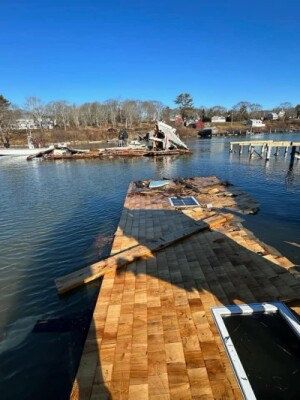
Thinking long-term, the Island Institute is also looking into lessons learned from other communities and other parts of the world. “We’re looking at the science in terms of predicting what’s going to happen,” says Battista. “If the tide is this high and the storm surge is this high, what’s going to get wet? We’re working on resilience upgrades with the Maine Climate Council and the Working Waterfront Coalition, and we’re learning from river communities that face flooding regularly how to develop better warning systems so that people can get inventory and equipment out of harm’s way.”
The wheels are turning in Maine to deal with the immediate impacts of the January storms and the long-term implications. As shoreside businesses race to get operational by spring, many agencies, organizations, and businesses are looking at how to rebuild for the future.





